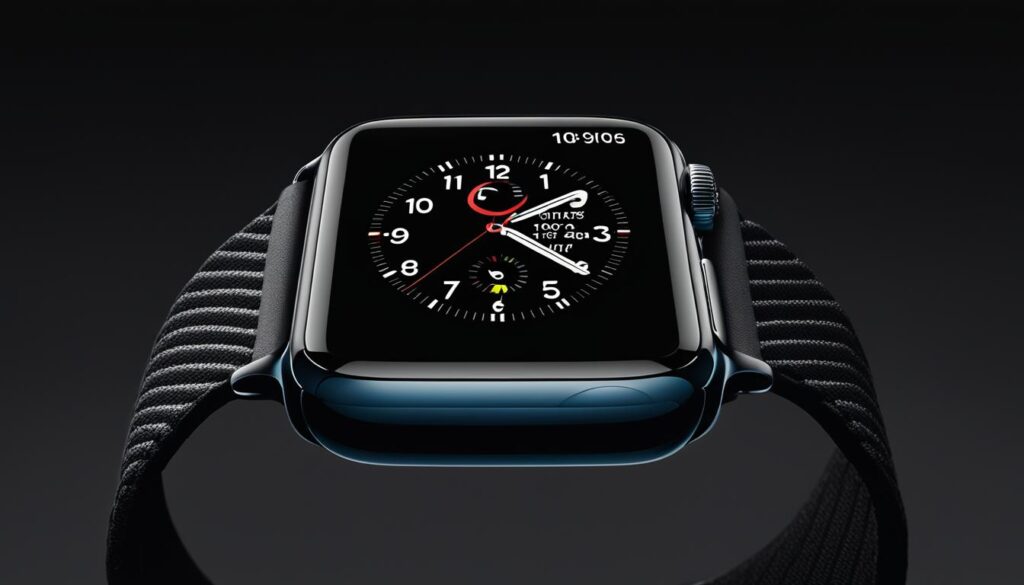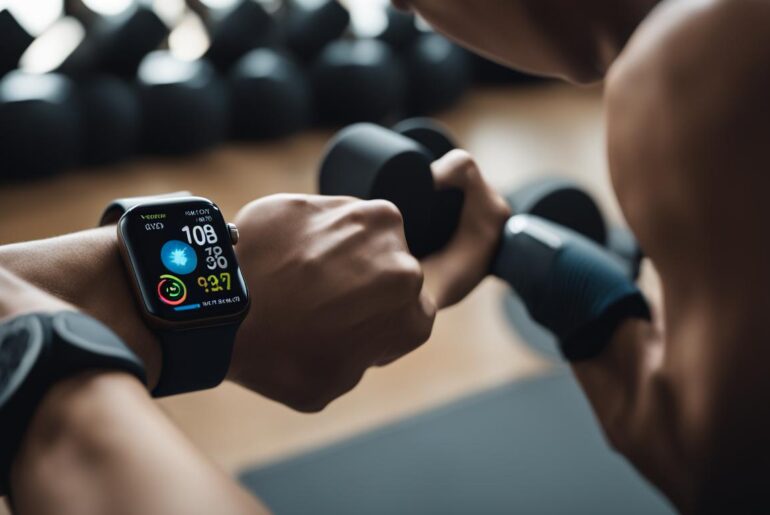The Apple Watch is a versatile fitness tracker that allows users to monitor various exercises and activities. However, when it comes to strength training, tracking workouts can be a bit challenging. In this article, I will share different methods and apps that can help individuals add strength training to their Apple Watch, optimizing their gym sessions for maximum results and progress (check out my post on add strength training here).
Key Takeaways:
- Adding strength training to your Apple Watch can enhance your fitness routine and help you reach your goals more effectively.
- The built-in Workout app offers some strength training options, but lacks detailed tracking of reps, sets, and weight lifted.
- Utilizing the Voice Memos feature on your Apple Watch can be an alternative method for recording your strength training performance.
- Third-party apps like Fitbod, Gymaholic, and Strong provide customizable workouts and comprehensive tracking features for strength training.
- Integrating strength training into your Apple Watch routine can be done with any of Apple’s latest models, including the Apple Watch Ultra, Series 8, and SE.
The Benefits of Logging Your Workouts
Keeping a workout log can have multiple benefits, especially for weightlifting. It helps you track your progress and allows you to easily plan your gym sessions. By documenting your lifts and sets, you can monitor your strength training progress over time. Additionally, a workout log can serve as motivation, reminding you of how far you’ve come and keeping you focused on your goals.
Tracking your workouts in a log provides a visual representation of your hard work and accomplishments. It allows you to see gradual improvements and identify areas where you can push yourself further. When you record the weight, reps, and sets for each exercise, you can analyze your performance, identify patterns, and make necessary adjustments to optimize your training.
Using a workout log can be a powerful tool for workout planning. By reviewing past workouts, you can strategically structure your future sessions to target different muscle groups and ensure balanced strength development.
A workout log not only helps you analyze your physical progress but also boosts motivation. When you look back at previous entries and see how much you’ve accomplished, it reinforces your dedication and drive. It serves as a tangible reminder of your commitment to your fitness journey and encourages you to stay consistent.
Sample Workout Log
| Exercise | Sets | Reps | Weight |
|---|---|---|---|
| Bench Press | 3 | 8 | 185 lbs |
| Squat | 4 | 10 | 225 lbs |
| Deadlift | 3 | 6 | 275 lbs |
Logging your workouts not only provides valuable data but also holds you accountable. It creates a sense of responsibility to consistently show up and put in the effort. Additionally, a workout log gives you the opportunity to celebrate milestones and breakthroughs, no matter how small, which can further fuel your motivation and determination.
Remember, consistency is key when it comes to strength training. By incorporating a workout log into your routine, you can effectively track your progress, plan your workouts, and stay motivated on your fitness journey.
Apple Watch’s Built-in Strength Training Workouts

When it comes to monitoring strength training workouts on your Apple Watch, the built-in Workout app offers some functionality. However, it primarily focuses on calorie and heart rate tracking, lacking in-depth metrics for reps, sets, and weight lifted.
Nevertheless, if you have a watch with watchOS 7 or newer, you can still make the most of functional strength training and traditional strength training exercises. These workouts provide specific guidance and tracking options tailored to your strength training needs.
For users with older watchOS versions, while the built-in app may not offer specific strength training metrics, you can still manually add your workouts to keep track of your progress over time.
To give you a better understanding of the differences between functional and traditional strength training, here’s a breakdown:
| Functional Strength Training | Traditional Strength Training |
|---|---|
| Focuses on exercises that mimic everyday movements | Focuses on classic strength exercises like bench press and squats |
| Improves overall physical performance and muscle endurance | Targets specific muscles to increase strength and muscle size |
| Uses bodyweight exercises, resistance bands, and functional training equipment | Uses free weights, weight machines, and barbells |
Functional Strength Training Examples:
- Squats with a medicine ball
- Push-ups with rotation
- Lunges with dumbbells
Traditional Strength Training Examples:
- Bench press
- Deadlifts
- Shoulder press
By incorporating functional and traditional strength training exercises into your Apple Watch routine, you can optimize your workouts and track your progress more effectively.
Using Voice Memos for Data Collection
Despite the limitations of the Workout app, there is a clever workaround to track your strength training performance with the Apple Watch. By utilizing the Voice Memos feature, you can seamlessly collect your workout data without the need to manually type out each set and statistic. This convenient alternative to pen and paper allows for effortless data collection while focusing on your lifts.
During your strength training session, simply activate the Voice Memos app on your Apple Watch and speak your totals, such as the number of reps, sets, and weight lifted, as you complete each exercise. The Watch captures your voice and creates an audio recording, providing you with a hassle-free way to collect your workout data.
One of the advantages of using Voice Memos for data collection is its simplicity. Instead of pausing your workout to jot down information, you can stay in the flow and maintain your momentum. This seamless data collection method minimizes distractions and allows you to give your full attention to your strength training routine.
While using Voice Memos alone may lack the immediate reference of past lifts, it still offers a practical solution for those who prefer an audio-focused approach. By listening to your recordings after your workout, you can manually input the data into your preferred fitness tracking app or spreadsheet for a comprehensive overview of your training progress.
Another advantage of using Voice Memos is its compatibility with various fitness tracking apps available for the Apple Watch. With these apps, you can easily import your audio recordings and have the data analyzed and logged automatically. This integration streamlines the process of tracking your strength training progress and provides you with valuable insights into your workouts.
Using Voice Memos for data collection on the Apple Watch offers a seamless and efficient way to track your strength training performance. By speaking your totals during your workouts, you can easily collect data without interrupting your training. Whether you prefer manual data input or integration with third-party apps, this method provides a convenient alternative to traditional note-taking methods.
| Pros | Cons |
|---|---|
| Seamless data collection during workouts | Lacks immediate reference for past lifts |
| Allows for uninterrupted training | Requires manual input of data after the workout |
| Integration with fitness tracking apps | May not be suitable for visual learners |
Third Party Apps for Strength Training
If you prefer using third-party apps, there are several options available for strength training with the Apple Watch. Fitbod, Gymaholic, and Strong are highly recommended apps that offer customizable workouts, tracking of reps, sets, and weight, and integration with Apple Health. These apps cater to users of different fitness levels, from novice lifters to advanced strength training enthusiasts.
Fitbod
Fitbod is a comprehensive fitness tracking app that provides personalized strength training plans based on your goals, available equipment, and performance. The app utilizes advanced algorithms to generate workout programs that optimize muscle activation and ensure balanced training. With detailed exercise instructions and real-time feedback, Fitbod helps you perform each exercise correctly and safely. It also tracks your progress, adapts workouts based on your performance, and syncs seamlessly with your Apple Watch.
Gymaholic
Gymaholic is another popular fitness app designed specifically for strength training. It offers a vast exercise library with videos and detailed instructions, making it easy to learn new exercises and maintain proper form. The app allows you to create custom workouts or choose from pre-designed plans tailored to your goals and experience level. With Gymaholic, you can track your reps, sets, and weights using your Apple Watch, ensuring accurate and efficient workout tracking.
Strong
Strong is a simple yet powerful strength training app that focuses on tracking your progress and providing valuable insights. It allows you to create and customize your workouts, record your sets, reps, and weights, and track your exercise history. Strong’s intuitive interface and advanced analytics help you visualize your training patterns, identify areas for improvement, and stay motivated on your fitness journey. The app seamlessly syncs with your Apple Watch, providing a convenient and efficient way to log your strength training sessions.
| App | Features | Integration with Apple Health |
|---|---|---|
| Fitbod | Personalized workout plans Exercise instructions Real-time feedback |
Yes |
| Gymaholic | Wide exercise library Customizable workouts Reps, sets, and weight tracking |
Yes |
| Strong | Progress tracking Exercise history Advanced analytics |
Yes |
The Apple Watch Ultra and Other Models

The Apple Watch Ultra is a premium fitness tracker specifically designed for athletic-minded scenarios, including strength training. With its advanced features and robust functionality, the Apple Watch Ultra is the ultimate companion for fitness enthusiasts. However, the benefits and features discussed in this article are not limited to the Apple Watch Ultra alone.
The technology and capabilities described can be applied to any of Apple’s latest releases, such as the Apple Watch Series 8 and the Apple Watch SE. These models also offer exceptional tracking potential and compatibility with the recommended apps for strength training.
Whether you choose the premium Apple Watch Ultra or opt for the latest Apple Watch Series 8 or Apple Watch SE, you can take advantage of the same comprehensive features and tracking capabilities. All these models are designed to enhance your fitness journey, providing accurate data and insights to optimize your strength training workouts.
Benefits and Conclusion
The Apple Watch offers a wide range of benefits for strength training enthusiasts, making it an excellent companion for your fitness journey. With its advanced features and capabilities, the Apple Watch can help you optimize your workouts and achieve optimal fitness tracking.
One of the key advantages of using the Apple Watch for strength training is its ability to monitor your performance in real time. With accurate heart rate tracking and motion sensors, the Apple Watch provides valuable insights into your training intensity and calorie burn, helping you stay on track and make informed decisions about your workouts.
In addition to performance monitoring, the Apple Watch allows you to track your progress over time. By logging your strength training sessions and recording your reps, sets, and weight lifted, you can easily visualize your improvements and identify areas for growth. This helps you stay motivated and focused on reaching your fitness goals.
In conclusion, integrating strength training into your Apple Watch routine can elevate your fitness journey to new heights. Whether you choose to manually log your workouts, leverage third-party apps like Fitbod, Gymaholic, or Strong, or invest in the latest Apple Watch model, you can take advantage of the Apple Watch’s benefits for optimal fitness tracking. So why wait? Strap on your Apple Watch, hit the gym, and transform your strength training experience.




